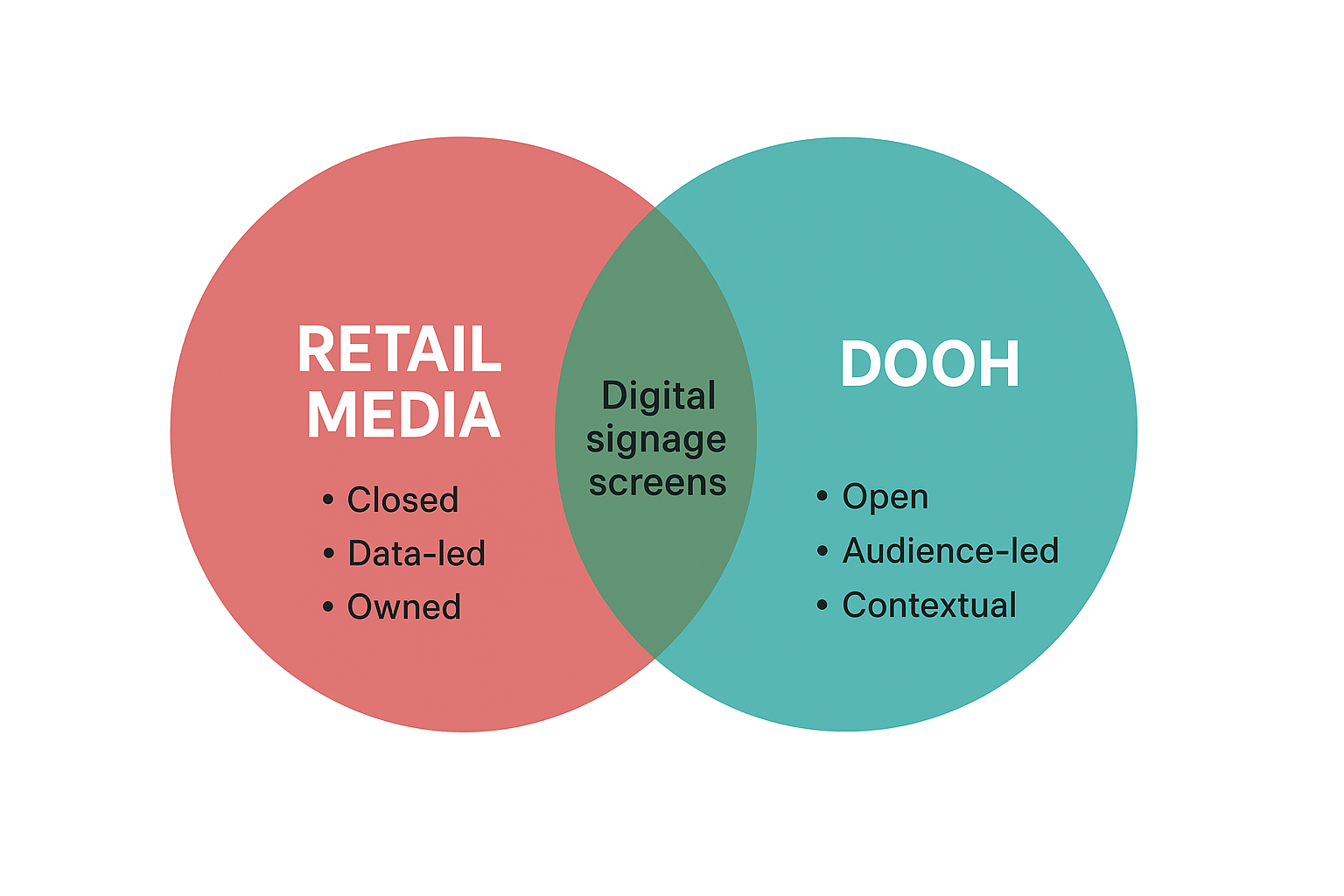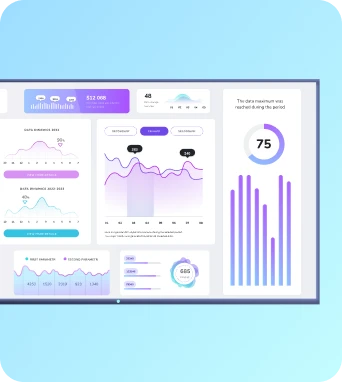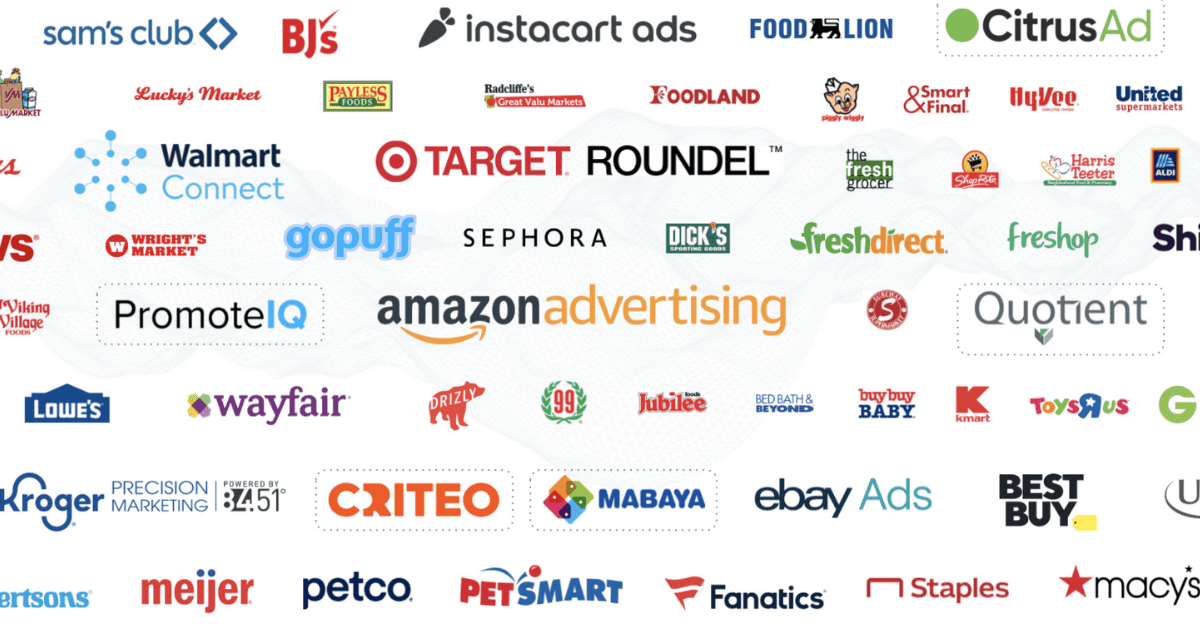There's no question that retail media has exploded into our marketing vocabulary. But the terminology has also become a bit... confused. I'm talking specifically about digital out-of-home advertising, or DOOH.
Because isn't retail media the same as DOOH? 🤔
Not quite.
Retail media is a data concept, and DOOH is a media concept. You can use both tactics to build a great advertising strategy. But you cannot use the terms interchangeably.
This article explains retail media versus DOOH advertising, shows how they're both different and the same, and explains why advertisers should care.
We'll start with the latter and work our way backwards:
Why care about the distinction between retail media vs DOOH?

Treating in-store retail media like DOOH is a huge mistake for growing brands. That's because not all shoppers are 100% online — and not all advertising done on a digital screen has the same effect on customers.
Even after a global pandemic pushed almost everything online, people never gave up their love of shopping in person.
The statistics speak for themselves:
- Around 44% of shoppers say it's their favorite retail channel
- 64% of consumers still shop in-store every week
- More than 80% of retail sales will still happen in brick-and-mortar locations in 2025
So what does this tell us? That shoppers' habits haven't changed, but the advertising mix has. We still need to push ads outside of our own stores and websites. But the line between them can be blurry, especially as physical stores get smarter and more connected.
This, dear reader, is where the tension lies.
Two industries, one audience, and a rapidly blurring line between what counts as “retail media” and what counts as “digital out-of-home.”
So on that note, let's dive into some definitions.
What is retail media?
Retail media refers to an advertising strategy that reaches shoppers through a specific retailer's owned properties. This includes first-party data (think shopping preferences and recent transactions), as well as owned digital or physical channels (like in-store kiosks and in-app ads).
Retail media helps brands reach consumers in spaces that would otherwise be unavailable. They may also have access to specific AdTech features such as target ads, sponsored content, and personalization tools.
There are two different types of retail media solutions:
- On-site advertising. These are ads and videos you can advertise on a retailer's owned properties. For example, Target's website, the Amazon Prime Streaming app, or even physical stores.
- Off-site advertising. This is when retailers let advertisers use its own first-party data (aka, cookies) to reach customers on third-party channels that it doesn't own. For example, Kroger's first-party data may suggest a certain shopper loves purchasing Dorito products. That way, you can create retargeting ads on social media or other websites to direct these shoppers to the Doritos store.
Keep in mind retail media isn’t just another ad format. It's technically an ownership model: retailers are publishers of their own inventory. You'll have access to ad spaces you otherwise couldn't have tapped into, as well as first-party data only that specific retailer could provide. And it's not just confined to a website banner or search ad, either — it’s moving onto walls, kiosks, and digital shelves.
- Shopper marketing
- Packaged media
- Commerce media
- Retail media networks (RMNs)
Either way, the meaning is the same: an ecosystem of data and proprietary space you can rent from established retailers.
How the retail media model works
With the launch of Amazon's Ads Platform in 2012, the world gave birth to the world's first retail media network. We've had quite the retail media revolution since then. Today, retail media is a $160 billion digital media channel, netting up to $1.63 per every dollar spent.
So how do retail media networks work? First, you apply to become a partner on the platform. You'll typically talk to a member of the sales team. Then, you're given a range of what to expect for ad spend. This heavily depends on the service you want (i.e., onsite versus offsite marketing spend). Finally, you can set up advertising campaigns from your admin dashboard. This allows you to track ad units, calculate advertising revenue, and compare product sales with ad performance and analytics.
So which retail media network do you pick? Frankly, that depends on the solutions you're looking for.
Here are a few of the most popular retail media networks:
- Amazon Ads: The dominant pioneer, with around ~75% US share. Its new Retail Ad Service extends AdTech to other retailers, which can help broaden the benefits of retail media (more on this later).
- Walmart Connect: Currently expanding in-store and digital reach via a Display Advertising API.
- Kroger Precision Marketing: Offers connected or linear TV, onsite brand activations such as coupons, and offsite digital advertising solutions.
There's a whole lot more to explore in the retail media ecosystem, and a lot we can't get into the weeds on here.
But suffice it to say there are a bunch of retail media networks available to help you build new revenue streams.
The benefits of retail media
The biggest benefit of retail media is its access to data and revolutionary AdTech. You can think of it like a technical and experiential type of social driven by relevance, attribution, and shopper context.
A few other benefits to keep in mind:
- Access to first-party data: Coupled with third-party cookies, you can travel with customers across the open web to deliver targeted advertising on their platform(s) of choice.
- Tap into limited digital channels: Most media companies focus digital campaigns around AdWords, social media, and other publicly accessible platforms. But retail media networks let you buy advertising in a more selective ad space, including e commerce platforms like Wayfair and eBay.
- Cutting-edge AdTech: Retailers are turning stores into interactive media canvases where customers can genuinely engage with advertising platforms. It's rapidly moving from ad slots to experiences — like the ability to add impulse purchases by tapping popups on a checkout screen, for example.
- Data-activated brand environments. Translated from "jargonese," this means you can personalize your advertising campaigns to the individual user. Some retail media kiosks can offer up hyper-relevant content when shoppers walk by, such as stock availability, seasonal promotions, or location-specific discounts.
- Closed loop measurement: This means measuring how customers before and after they're exposed to your ad. This is harder to track with DOOH, since consumers might only get a quick glance before continuing on. Retail media companies can track consumer behaviors inside their store and app(s) so you can get a better idea of your ad performance. For example, whether or not it led someone to check out.
What is DOOH?
DOOH stands for digital out-of-home advertising, which refers to digital media inventory that's sold in public or semi-public spaces. For example, digital billboards, mall screens, airport displays, and transit signage. These digital signage screen are owned by media networks, not retailers. They're typically priced based on audience impressions, screen location, and dwell time.
You can use DOOH for renting space on a digital network rather than buying ad real estate outright. Your ad shows up where your people are — on their commute, at the gym, in-store, etc. — so you can connect brand messages with your audience in the physical world.
Of course, DOOH doesn't offer first-party data you can track on the open web, or select placements with advertisers that are ordinarily out of reach. But it does help brands reach consumers as they go about their days and keep your brand top of mind.
A few examples of DOOH placements include:
- Digital billboards along highways or in urban centers
- Interactive mall or airport kiosks
- In-store displays or checkout screens in retail environments
- Programmatic ad slots on connected public displays
How DOOH advertising works
Most advertisers rent or lease screen time across high foot-traffic locations, from shopping malls, airports, and subway stations to vehicle screens, elevators, and digital kiosks. You can purchase these slots from large media companies, local government authorities, and some select retailers and providing brands (such as malls and public transit officials).
Then, you're given access to an ads dashboard and account manager to help you manage campaigns through Demand-Side Platforms (or DSPs). These can help automate where and when your ads appear based on audience data, time of day, or even live conditions like weather or traffic.
Once your campaign is live, you might have access to analytics such as impressions, dwell time, and engagement metrics. Just don't expect the same performance visibility you’d get from online ads.
But you will have plenty of options for ads in different stages of your market.
Here are a few examples of DOOH in action:
- Programmatic DOOH: Automates ad buying, letting brands bid in real time for available screen space.
- Interactive signage: Touchscreens or motion sensors that invite customers to engage directly.
- Dynamic creative: Content that changes automatically based on data triggers (like a coffee ad that appears only when it’s raining ☔).
The benefits of DOOH advertising platforms
DOOH advertising blends the power of traditional outdoor media with the precision and flexibility of digital technology. That way, you can tap into the magic of targeted advertising without feeling stuck with digital channels.
In fact, DOOH advertising helps brands:
- Rent digital advertising space anywhere: From bustling city centers to gym lobbies and airports, DOOH gives you access to premium physical spaces.
- Gain more control over social commerce: You can run time-sensitive or location-specific campaigns that push customers directly to online offers. This helps bridge the gap between offline attention and online conversion.
- Get massive reach with contextual precision: DOOH ads can target consumers based on time, place, and environment. That way, you can reach the right audience when they’re most receptive to making purchase decisions. Like commuters seeing breakfast ads during their morning rush.
- Create dynamic, data-driven creative: Automatically update content based on live data such as weather, traffic, or event schedules. For example, you might show off an ad for sunscreen during an unseasonably big wave of heat.
- Ensure brand safety and visibility: Unlike advertising on digital channels, DOOH ads live in public spaces. You have a little less risk of appearing next to questionable content or disappearing into a consumer's search results.
Retail media vs DOOH
Now that you're familiar with both retail media, and DOOH, let's compare and contrast them so you can see the difference for yourself.
First, let's break everything down in a handy comparison chart:
Type | Access to first-party data | Intent | ROI measurement | Funnel stage | Content personalization | Targeting | Physical spaces | Digital spaces |
Retail Media | ✔️ | Drives purchase decisions | Built-in analytics | Middle to bottom | High | Based on real-time targeting | ✔️ | ✔️ |
DOOH | ❌ | Drives awareness | Simple KPIs and equations | Top to middle | Low | Based on location data | ✔️ | ❌ |
The quick version? Retail media own the split-second moment of influence when shopper attention turns into purchase intent. DOOH, on the other hand, increases how long these moments last by engaging shoppers from afar.
So, yes: DOOH and in-store retail media programs use the same devices, or digital screens, to deliver messages. But these two ad formats are fundamentally different and require deeper understanding so brands can use them successfully.
Using retail media and DOOH with digital signage
By now it should be easy to see why DOOH and retail media's important. Sure, they're both types of digital signage advertising, but they are not the same thing. And you're going to need both to maximize your benefits.
But there's a whole lot out there to keep your eye on. Look at Carrefour and Criteo, for example: commerce data drove personalized in-store campaigns, a sneak peek at what hybrid retail media and DOOH activations can do. Plus, AI and data triggers are taking OOH from static displays to live, responsive content, which is creating new opportunities for measurable engagement.
The cherry on top? Every brand can access this type of digital signage content, whether or not it wants to run an ad campaign. Platforms like Fugo let you create physical and digital signage content such company TV channels, touch content, dynamic playlists, and more.
With Fugo, you can:
- Deliver real-time, personalized messaging across multiple store locations
- Turn every screen into a live, actionable dashboard for staff or shoppers
- Automate content updates based on triggers like sales, inventory, or campaigns
So if you're curious to digital and physical signage content before diving headfirst into ads...
Start your 14-day free trial with Fugo today and explore the possibilities.
Frequently asked questions about retail media
Q: What is retail media?
Retail media is a type of advertising that shows up on a retailer’s digital properties. For example, websites, apps, or even in-store screens. This allows brands to reach shoppers right at the point of purchase. Plus, you can serve hyper-specific retail media ads based on third-party cookies.
Q: Is DoorDash a retail media network?
DoorDash operates a retail media network through DoorDash Ads, which lets brands promote products to customers within the DoorDash app. For example, a local food company could pay for sponsored ads that help them appear at the top of search results when someone orders lunch. This makes it easy to use shopper data and retail media space to reach relevant audiences. Plus, you can influence buying decisions in real time.
Q: What is the largest retail media advertising network?
Amazon leads the charge as the world's largest global retail media advertising solution, accounting for 75% of retail media ad revenue share worldwide. Other leading brands include Walmart Connect, Instacart Ads, Target’s Roundel, which measure second, third, and fourth largest retail media solutions in the world (respectively).
Q: What is the difference between DOOH and billboards?
DOOH stands for digital out-of-home advertising. This includes any digital advertising for spaces outside your business, including malls, bus stations, and video walls in Times Square.
Billboards are a type of OOH (or out-of-home) advertising. That means it's a static part of the retail media industry and can't exist online or in digital spaces.
All traditional static billboards are considered OOH advertising — but digital billboards may count as DOOH.
So to summarize: DOOH advertising can sometimes include billboards, but most traditional billboards aren't digital spaces.
Q: Should I use DOOH or retail media?
This entirely depends on your specific business needs.
But there are still a few rules of thumb you can follow:
- If you want a public-facing broadcast to make a big, splashy impact, DOOH will be the right tool for the job.
- If you want targeted, data-driven, shopper-focused ads to drive direct sales, the retail media landscape will be your best bet.





